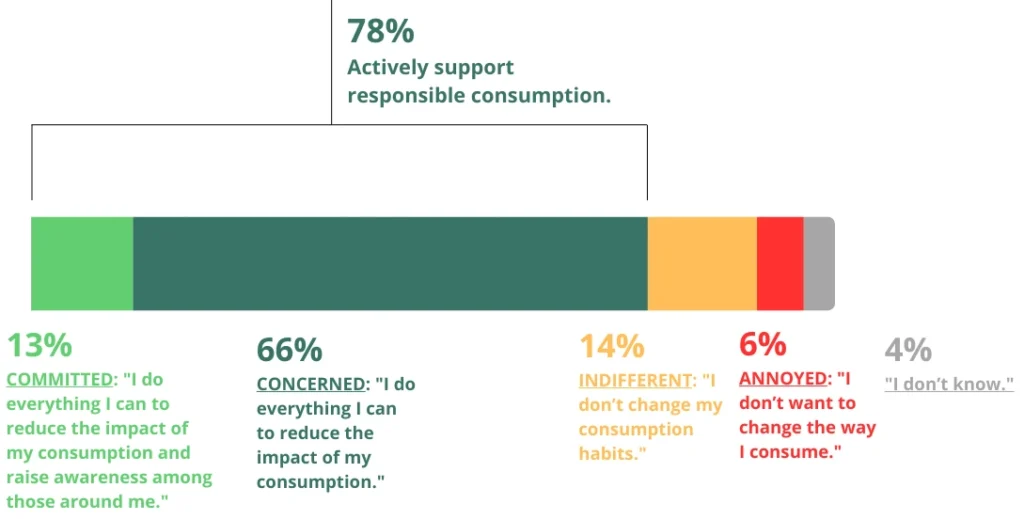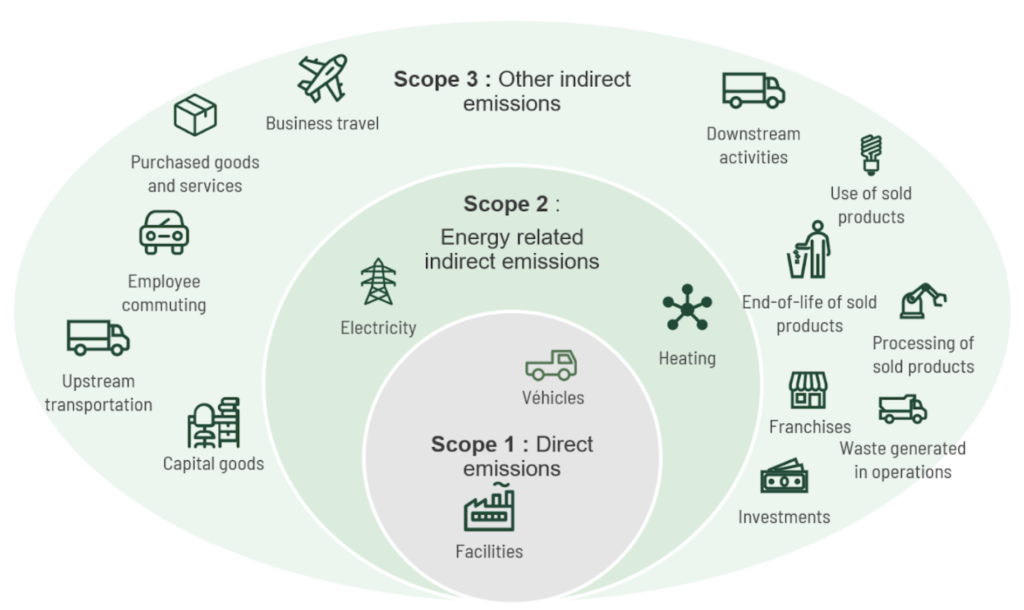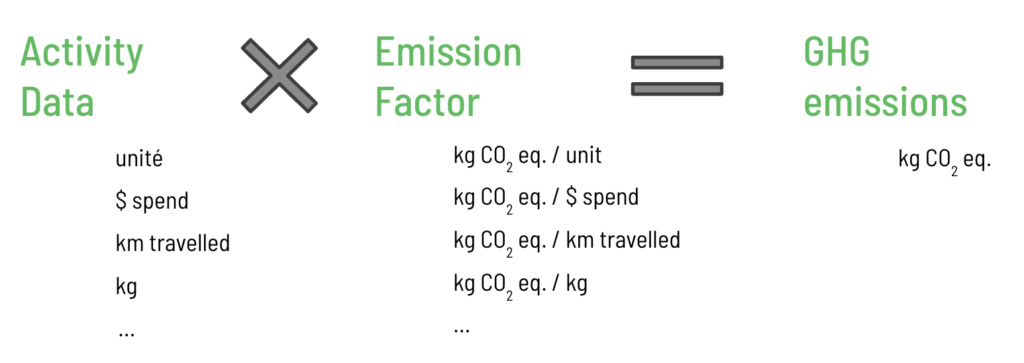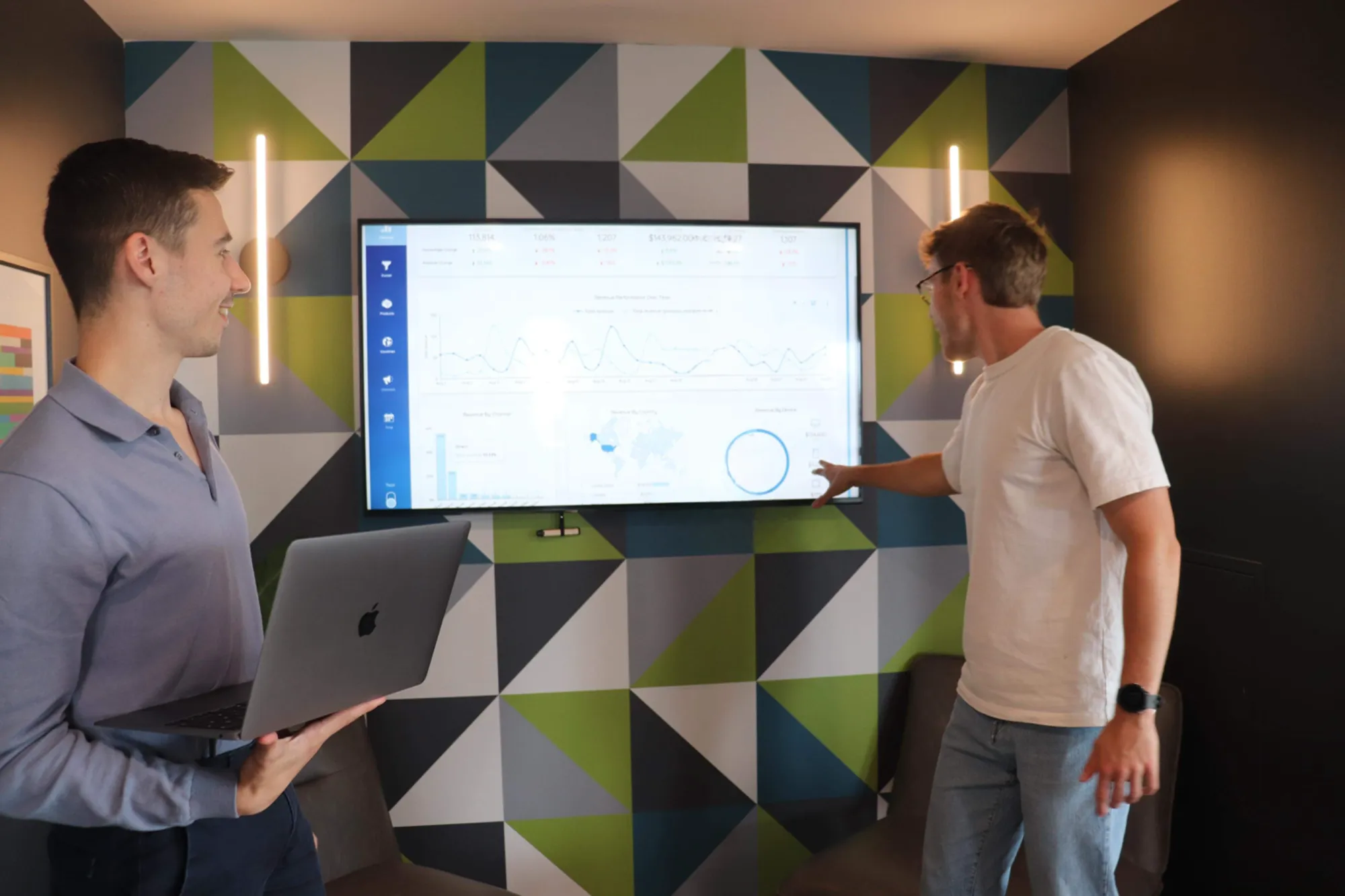Introduction: The Corporate Carbon Footprint
Should you take the time to focus on your corporate carbon footprint? Absolutely. In 2025, it’s no longer optional—it’s a necessity. Why? Because if you don’t, you risk falling behind your competitors, and your increasingly environmentally conscious customers may turn elsewhere. It’s as simple as that.
According to a study from the 16th ADEME Barometer, environmentally conscious consumers are growing by 2.6% annually, reaching 78% of the French population and 65% of the Canadian population in 2023. So, why not get started now and join the collective effort?

What is a Corporate Carbon Footprint?
While many people understand what we mean by a corporate carbon footprint, we prefer to provide a clear definition. A carbon footprint is an analysis that identifies all sources of emissions, both direct and indirect, from a company to quantify its environmental impact. Think of it as your environmental scorecard. This score calculates the greenhouse gas (GHG) emissions generated by your business.
Today, it’s essential to know your environmental score to account for your impact on the environment, benchmark against competitors, improve your practices, and share the efforts made throughout the year. Many companies are making efforts, but without comparable figures or verified data to provide, communication often remains vague. At best, this has less impact, and at worst, it can fall under anti-greenwashing laws (we invite you to read our article on Canada’s new C-59 law, which addresses this issue).
Why Should Companies Conduct a Corporate Carbon Footprint?
Before diving deeper, in case you’re still not convinced of the relevance of this approach, here are the major benefits you’ll gain from conducting your first carbon footprint assessment.
Cost Optimization
This might seem surprising, but conducting a carbon footprint can improve your finances. By mapping out all of a company’s costs, you can clearly identify where waste and pollution occur and take planned measures to optimize everything. Indeed, through a detailed analysis of emission sources, you can uncover greenhouse gas emissions that represent waste—and opportunities for savings.
For example, outdated and energy-intensive equipment can lead to process inefficiencies, increased costs, and higher CO₂ emissions for the company. By replacing them with more efficient models, your business can reduce energy consumption and associated costs. Similarly, reducing waste generated by your operations will lower associated greenhouse gas emissions while decreasing expenses related to waste disposal and material recovery. “The easiest waste to eliminate is the waste you never produce.”
Thus, the carbon footprint often reveals close links between a company’s emissions and its expenses, offering concrete pathways to improve both its environmental impact and profitability.
“26% of companies perceive significant or substantial benefits or business opportunities related to climate action.”
Source: Quebec Net Positif, Barometer 2023
Compliance with Current and Future Regulations
New environmental laws are being introduced every year. By conducting your carbon footprint assessment, you can meet your country’s legal requirements before they even come into effect. This means less stress, fewer risks of penalties, and a head start over your competitors. For example, Canada implemented the Canadian Sustainability Disclosure Standards (CSDS) in 2025, which, if adopted, will require companies to be transparent about their annual GHG emissions. It’s better to be green by the time these regulations take effect to avoid alienating your customers.
Enhanced Sustainable Marketing and Brand Image
Because for a business to succeed, it needs customers. We can’t stress enough how important brand image is, but we sometimes forget the impact it has on consumer choices. According to a study by Agriculture and Agri-Food Canada, 65% of Canadian consumers feel a moral obligation to use environmentally friendly products, and 50% believe that a company’s values are important and should emphasize sustainability.
By showing that you take your carbon footprint seriously, you improve your reputation and attract customers who share your values. This is a significant competitive advantage that will only grow over time.
A Contribution to the Fight Against Climate Change
Let’s be honest: conducting a carbon footprint isn’t just about making money. It’s a way to demonstrate your commitment to the environment and participate in the collective effort for the planet’s future. And in some way, we believe that acting with this purpose gives meaning to the actions you take in your business every day.
The Guide to Conducting a Corporate Carbon Footprint in 5 Steps
1. The Three Key Scopes to Know

Before going further, it’s important to define the level of complexity of the carbon footprint you want to conduct. This is why you need to understand the three scopes or fields of application to measure when developing your carbon footprint. This will help you set your goals in terms of quality and available time.
- Scope 1 covers direct emissions from the company. These can be generated by the company’s physical or chemical processes, related to the consumption of fossil fuels in its vehicles, equipment (furnaces, boilers, etc.), or refrigerants in its cooling systems.
- Scope 2 concerns indirect emissions related to energy. These mainly include emissions associated with the electricity purchased by the company, as well as any district heating, steam, or chilled water networks that supply the company’s buildings.
- Scope 3 encompasses all other indirect emissions from the company’s value chain. This includes emissions related to upstream and downstream transportation, purchased products and services, business travel, and employee commuting.
The most significant scope, accounting for approximately 80% of a company’s emissions, is Scope 3. This is the scope that allows you to go further in your environmental efforts, but it’s also the most time-consuming to calculate. If you want to conduct a comprehensive carbon footprint that includes Scope 3, we recommend working with carbon experts, as you’ll need to cross-reference and estimate a lot of data that you may not have direct access to.
Although Scope 3 is complex, you’ll understand that without calculating 80% of your emissions, your carbon footprint may seem incomplete and might not meet certain laws or standards. This is also why companies generally only communicate their results after completing Scope 3, to avoid promoting partial environmental benefits. Doing otherwise could harm your brand image or even lead to legal issues, depending on your location.
If you’d like to calculate your GHG emissions for Scope 3, feel free to contact us or schedule a free consultation so we can guide you through the process.
2. Define the Scope
The first step in conducting a carbon footprint is to clearly define the scope of the study. It’s crucial to determine the period for which emissions will be accounted. We strongly recommend aligning this period with the company’s fiscal year so that the carbon footprint data can be compared with the company’s financial results. The NCID 1 and 2 standards will also require detailed information on greenhouse gas emissions to be communicated X months after the end of the fiscal year.
Additionally, if your company exceeds a certain size and has subsidiaries or other associated entities, it will be important to define how the results will be consolidated. Two approaches exist:
- The Financial Approach: The organization consolidates results based on the financial control it has over other entities. This approach is more suited to financial organizations.
- The Operational Approach: The organization consolidates results from entities over which it has decision-making power regarding operations. This doesn’t necessarily mean your company has full control over the entity, but it is able to implement its operational procedures there.
3. Collect the Data
Now that the scopes to be calculated are defined, we have a clear picture of the different data to collect. The goal here is to gather all relevant information about the company’s activities that may have generated GHG emissions. This includes energy consumption (electricity, gas, fuels), business travel, waste production, raw material purchases, and more. To ensure the reliability of the carbon footprint, it’s essential to have as much accurate data as possible on hand.
Tips for Effective Data Collection:
- Involve Internal Stakeholders: Collaborate with various departments within the company (accounting, procurement, production, logistics) to gather data quickly and efficiently.
- Use Tracking Tools: Implement a data collection tracking system to ensure nothing is overlooked. This also helps hold accountable the different stakeholders who have access to specific types of data, preventing the process from stalling at 25% completion.
- Verify Data Quality: Ensure the reliability and consistency of the collected information by conducting regular checks. This step helps clarify and minimize the company’s emissions in the long term.
4. Calculate Emissions
After gathering all the data, what do you do with it? The next step is to calculate the GHG emissions associated with the company’s various activities. To do this, emission factors are used to convert activity data (for example, the amount of fuel consumed) into CO₂ equivalents.

Calculation Methods:
- Physical Approach: Based on measurable physical data, such as liters of fuel consumed or kilowatt-hours of electricity used. This calculation relies on international standards for greenhouse gas accounting, such as the GHG Protocol.
- Monetary Approach: Used when physical data is unavailable, this method estimates emissions based on financial expenditures. It relies on data recorded by your country when it tracks GHG emissions generated per $/€ in your industry sector.
It’s preferable to use the physical approach whenever possible, as it provides a more accurate estimate of emissions.
5. Analyze the Results
Once the results are obtained, it’s crucial to analyze them. This will help you clearly identify where your largest sources of emissions are—and they might not be where you expect. For example, one of our clients was surprised to learn that business travel was their primary source of emissions, even though they sold products nationally.
To enable an analysis that allows you to make high-impact decisions quickly, we use a data table that filters results in an optimized way. We recommend setting up this kind of data table or consulting experts to analyze the results, as trying to interpret scattered data files will only complicate the process.
Example of a Final Corporate Carbon Footprint Report We Provide for Our Clients:
To learn more about our optimized data table, feel free to email us with your questions.
The Carbon Footprint is Done—Now It’s Time to Take Action
The carbon footprint is a way to demonstrate your commitment, but more importantly, it’s a tool for taking action. It enables you to make informed decisions that will improve your carbon footprint. You’ll need to set goals—specifically, a target for reducing emissions by year N+1, N+2, and so on. For reference, we recommend aligning with the Paris Agreement, signed by 193 countries, which advocates for a 43% reduction in emissions by 2030. These goals are largely based on the IPCC REPPORT (Intergovernmental Panel on Climate Change) report, which provides in-depth scientific analyses on climate change.
Your reduction target is a figure you can share with your customers, showcasing your environmental ambitions from the start. There’s no need to set an unattainable goal right away, as once you announce it to your consumers, you’ll need to stick to it. Note that transparent companies that share their efforts, even modest ones, meet expectations far better than those that sell dreams without taking action.
To achieve this reduction target, you’ll need to develop an environmental strategy aimed at identifying concrete actions to implement within your company.
“In Quebec, 73% of the population experiences eco-anxiety. Taking action is a great way to reduce this feeling of helplessness.”
Source: Léger, 2021 Survey
Here are some tips for identifying achievable actions for your business:
- Analyze what falls within your role/function: Identify actions you can take as a team member. The idea is to pinpoint a concrete action you can act on quickly, then gradually move toward more ambitious projects.
- Target the most significant emissions: However, balance this by considering which emission sectors to reduce. To meet reduction targets (5-15% annually, in line with the Paris Agreement), sometimes addressing a smaller source of GHG emissions is enough to start.
- Identify actions with associated costs for the company: This ensures the profitability of the actions identified. This final tip will help you gain support for your initial ideas from key stakeholders in your company.
Here are some examples of actions we’ve implemented for our clients:
- Improving energy efficiency: Optimize production processes, modernize equipment, or improve building insulation to reduce energy consumption.
- Promoting sustainable mobility: Encourage the use of less polluting transportation methods for business travel, such as carpooling, cycling, or public transit.
- Optimizing waste management: Implement waste reduction, reuse, and recycling programs to lower emissions associated with waste treatment.
- Employee awareness: Train and inform employees about climate change issues and best practices for reducing emissions in their daily work.
Our Final Tips for Getting Started Effectively
Prepare for the Process
It’s essential to define the objectives of the carbon footprint and mobilize internal stakeholders. You’ll need to train your teams and appoint a project leader.
Train or Hire a Carbon Expert
Conducting a corporate carbon footprint according to international reporting standards (ISO 14064-1) requires a deep understanding of the methodology and the specifics of emission sources. Internalizing these skills allows you to quickly initiate an action plan after completing the carbon footprint.
Engage a Specialized Company
If you don’t have the time or resources to train an in-house carbon expert, we recommend hiring a specialized company. Sustainscale offers its expertise to help businesses conduct carbon footprints according to international reporting standards. By engaging Sustainscale, you’ll benefit from a dedicated carbon expert and project manager who, in addition to handling data collection and calculation for you, will create a customized data table tailored to your needs. This will enable you to make high-impact decisions for your business throughout your operations.
7. FAQ: Frequently Asked Questions About Corporate Carbon Footprint
When Should You Conduct a Carbon Footprint?
We recommend doing it as soon as possible, even if current legislation doesn’t apply to your situation—it will eventually. Plus, it’s a key advantage for convincing prospects and building your business on strong values.
Who Can Conduct a Corporate Carbon Footprint?
Anyone who follows the specific methodologies of the GHG Protocol. This requires in-depth training to ensure compliance with standards. The person in charge should be comfortable with numbers, have strong communication skills, knowledge of analytical tools, and an understanding of the regulations applicable to their sector.
Carbon Footprint and CSRD?
The methods of the Carbon Footprint and GHG Protocol meet the requirements of the CSRD (Corporate Sustainability Reporting Directive) for criteria ESR-1 and 2. The CSRD requires companies with more than 250 employees to report their emissions starting in early 2025. From 2026, all companies, including Canadian ones, generating more than €40 million in revenue will also need to comply.
Additionally, this directive requires a Scope 3 inventory. So, if you have clients in Europe, they will likely need your data to integrate it into their GHG emissions inventory.
Is a Carbon Footprint Mandatory for All Companies?
It depends on the size of the company and the industry. However, it’s increasingly encouraged or even required. Feel free to contact us if you’d like more information about the legislation in your region.
What is the GHG Protocol?
It’s an international framework for accounting and reporting greenhouse gas emissions.
What is Carbon Offsetting?
Companies that cannot meet emission reduction targets must engage in carbon offsetting. This means investing in environmental projects to balance their climate impact that cannot be reduced internally.
What’s the Difference Between the Physical and Monetary Approach?
The physical approach is based on measurable data (liters of fuel, kWh of electricity), while the monetary approach is based on financial expenditures. The physical approach is more accurate.
Why is it Important to Include Scope 3?
Because Scope 3, which covers a company’s indirect emissions, represents the largest share of emissions. Measuring is improving, so it’s harder to enhance your carbon footprint without information on your biggest emission factor.
How Can I Get Funding for My Corporate Carbon Footprint?
As an Ecoleader expert, Sustainscale can help you secure up to 75% funding for services related to implementing actions if you represent a Canadian company.
Conclusion
The carbon footprint isn’t just a way to comply with legislation, nor is it solely a tool for improving brand image or saving money. It’s a strategic tool for companies that want to commit to sustainable development and address climate challenges. In 2025, it’s practically a must if you want to ensure the longevity of your business.
To conduct your first corporate carbon footprint, you’ll need to, in order: identify the data to collect, organize yourself to gather it, and calculate it according to standards. To do this, we recommend either training someone internally or contacting a specialized company.
Finally, the primary purpose of a carbon footprint is to take action. It will serve as your gateway to making informed decisions throughout the life of your business.
So, are you ready to become a key player in the ecological transition?
Need Help Developing Your Corporate Carbon Footprint? We Can Advise or Assist You.
Need Help Developing Your Carbon Footprint? We Can Advise or Assist You.
Sustainscale offers comprehensive support to help you achieve your first corporate carbon footprint. We’ll also help you become autonomous in your current and future decision-making, enabling you to become an ecological leader.


